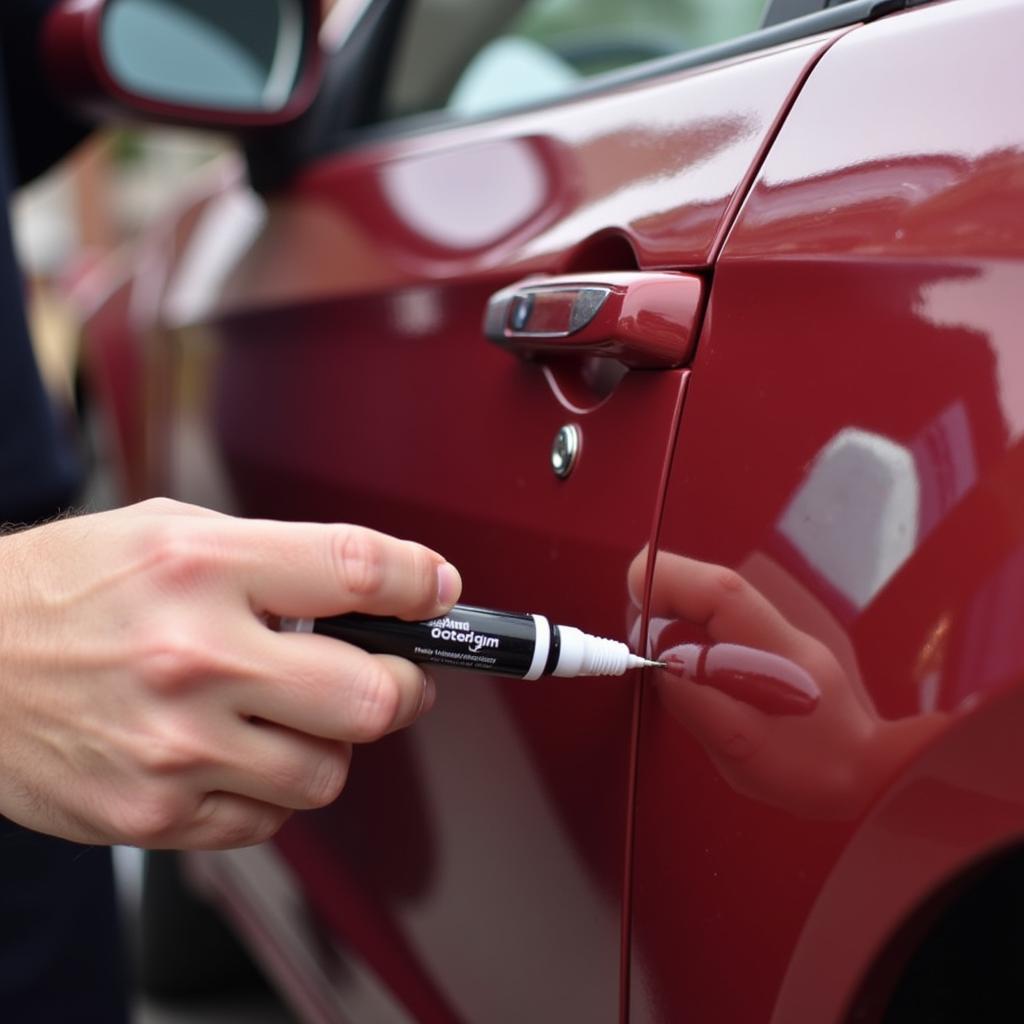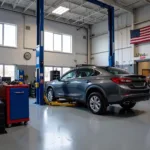Repairing a paint scratch on your car door can seem daunting, but with the right knowledge and tools, it can be a manageable DIY project. This guide will walk you through various methods, from simple touch-ups to more involved repairs, helping you restore your car’s appearance and protect it from further damage.
Fixing a minor scratch not only enhances your car’s aesthetics but also safeguards it against rust and other potential issues. We’ll cover everything from assessing the damage to choosing the appropriate repair method and executing it effectively. You can achieve professional-looking results without breaking the bank, even for more significant scratches. See our guide on how to repair small chips in car paint for dealing with minor paint chips.
Assessing the Damage: How Deep is the Scratch?
Before you start, it’s crucial to determine the severity of the scratch. Is it a clear coat scratch, or has it penetrated the base coat or even the primer? This assessment will dictate the necessary repair approach. A light scratch might only require a simple polish, while a deeper one might necessitate touch-up paint and clear coat. Knowing the extent of the damage will help you gather the correct materials and avoid unnecessary work. For deeper scratches, consider checking out our guide on repairing large paint chips on cars.
DIY Repair Methods for Paint Scratches
Several DIY methods can effectively repair paint scratches on your car door, depending on the depth and severity.
Minor Scratches and Swirl Marks
For light scratches and swirl marks that only affect the clear coat, a polishing compound or rubbing compound can often do the trick. These products work by gently abrading the clear coat to level out the imperfections. Apply a small amount of the compound onto a microfiber cloth and rub it onto the affected area using circular motions. Afterward, buff the area with a clean microfiber cloth to reveal a smooth, glossy finish.
Moderate Scratches Reaching the Base Coat
If the scratch has penetrated the base coat, you’ll need touch-up paint. Ensure you select the correct color code for your car. Apply the touch-up paint carefully to the scratched area, using a fine-tipped brush or a touch-up pen. Allow the paint to dry completely before applying a clear coat to protect the repair and blend it with the surrounding paint. Looking for DIY solutions for more extensive bodywork? Check our guide on car body paint repair DIY.
 Applying Touch-Up Paint to Car Scratch
Applying Touch-Up Paint to Car Scratch
Deep Scratches Exposing the Primer
Deep scratches that expose the primer require more attention to prevent rust. Clean the area thoroughly and apply primer if necessary. Then, follow the steps for repairing moderate scratches, applying touch-up paint and clear coat. For car paint repair services in Singapore, refer to our guide on car paint repair Singapore.
When to Seek Professional Help
While many scratches can be repaired at home, some situations warrant professional help. If the scratch is extensive, involves dents or deep gouges, or if you’re uncomfortable with DIY repairs, it’s best to consult a professional. They have the expertise and equipment to handle complex repairs and achieve a flawless finish. For reviews on professional car paint repair services, take a look at our car paint repair Whitburn reviews.
Conclusion
Repairing a paint scratch on your car door can significantly improve its appearance and protect it from further damage. By carefully assessing the scratch and choosing the appropriate DIY method, you can often achieve impressive results. However, don’t hesitate to seek professional help for more complex repairs. Regular maintenance and addressing scratches promptly will keep your car looking its best.
FAQ
-
How can I tell how deep a scratch is?
Use your fingernail to gently feel the scratch. If your nail catches, it’s likely deeper than the clear coat. -
Can I use nail polish to repair a car scratch?
While tempting, nail polish is not formulated for automotive paint and won’t provide a durable or color-matched repair. -
How long does touch-up paint take to dry?
Drying times vary depending on the product and environment but typically range from 30 minutes to a few hours. -
What’s the difference between rubbing compound and polishing compound?
Rubbing compound is more abrasive and used for deeper scratches, while polishing compound is finer and used for light scratches and swirl marks. -
How can I prevent future scratches?
Regular washing and waxing, parking carefully, and using protective films can help prevent scratches.
Expert Insights:
- John Smith, Automotive Paint Specialist: “Proper surface preparation is key to a successful paint scratch repair. Ensure the area is clean and dry before applying any product.”
- Maria Garcia, Car Detailing Expert: “Always use high-quality microfiber cloths to avoid introducing new scratches during the repair process.”
- David Lee, Auto Body Technician: “Don’t be afraid to seek professional help for complex repairs. It’s often more cost-effective in the long run.”
Related Articles: You might find these articles helpful: How to repair small chips in car paint? What are the best car paint repair services in my area?
Need Help? Contact us via WhatsApp: +1(641)206-8880 or Email: [email protected] for 24/7 support.

